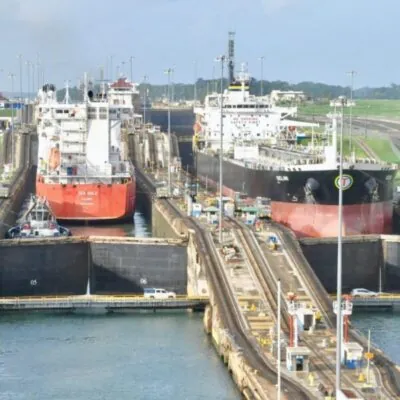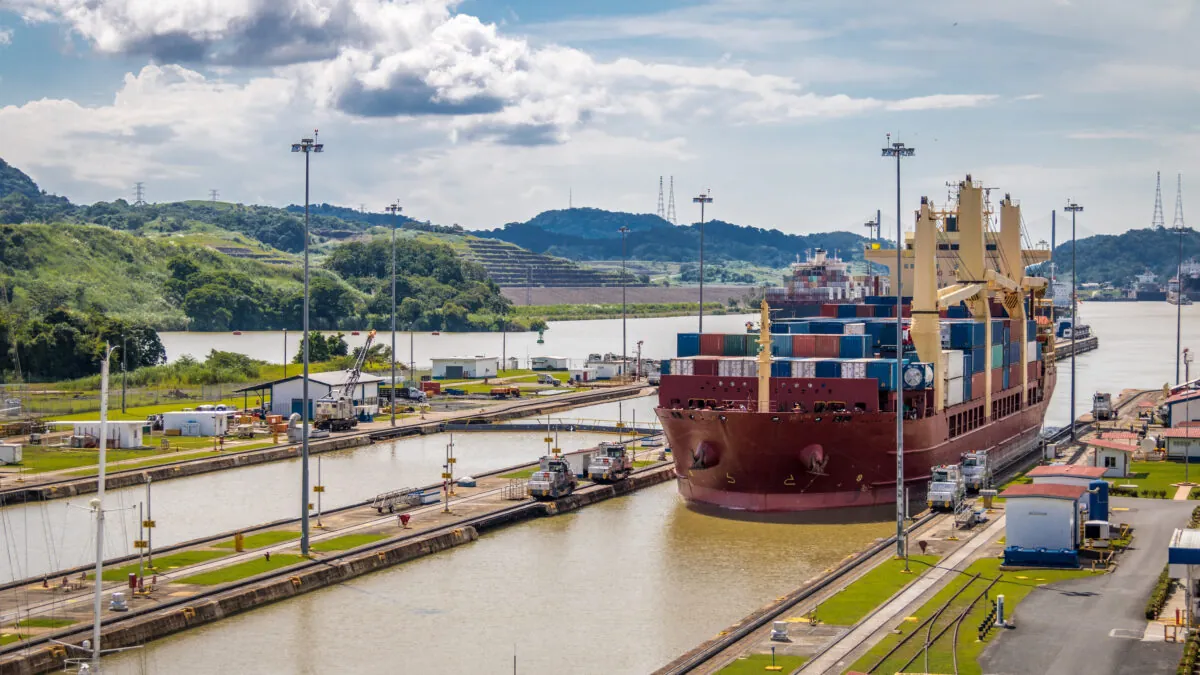
Panama Canal Drought
The Panama Canal has suffered from a severe drought in recent years, affecting the supply chain negatively. The Panama Canal is one of the world’s largest trading channels, and the unprecedented dryness brought about by the severe drought this past spring and summer has raised serious concerns about the year ahead. While Panama’s two seasons are the dry and rainy seasons, the country still faces the lowest rainfall since 2000, even with the rainy season that usually lasts from late April until late November.
Water is needed to flood the locks and float ships across Central America. With the lowest water levels in 109 years (since the Canal opened), this requirement has not been possible. The effects within the supply chain have been far-reaching, affecting the industry globally. Precipitation recorded for October has been the lowest since 1950 (41% below), with 2023 being the second-driest year. Meanwhile, the authorities believe that rainfall will be 38% below average for the rest of the year.
One of the most significant effects of the Panama Canal Drought lies in the low levels of water that cannot be easily replenished. Due to drought, the canals depend on lakes with nearly minimum water levels. These waterways are connected, with lakes flowing into channels that flow into nearby oceans.
Taking water from surrounding lakes and unconnected rivers would help alleviate the problem. Others say these waterways are a primary source of fresh water for the surrounding communities. Also, the water in the Canal is treated and used as a freshwater source. Additional salt from other water sources will be too much to desalinate.
Vessels rely on adequate water levels to propel them through the Canal. Low water levels as a result of the Panama Canal Drought, mean Panama Canal Congestion, delays, restrictions, and lengthy waitlists for months. As a result, these consequences affect every area of the supply chain, from shipper to consumer and everyone involved in between!
Panama Canal History
One of America’s dreams during the 1800s was to construct a more efficient and cost-effective passageway for shipping goods between the Atlantic and Pacific coasts. This dream was shared with Great Britain, with leaders and businessmen eager for the countries to propose a treaty.
In 1850, the US and Great Britain negotiated the Clayton-Bulwer Treaty for “The Anglo-American Canal.” Despite the negotiation, action never actualized past the planning stages. Meanwhile, Ferdinand de Lesseps, the French engineer behind the Suez Canal, began excavating in 1880. Nine years later, these plans folded and went bankrupt with a loss of approximately 20,000 lives due to causes including Tropical Diseases such as Malaria and Yellow Fever.
Despite the initial setbacks, American interest in building the Canal remained strong. In 1901, the Hay-Pauncefote Treaty abrogated the initial Clayton-Bulwer Treaty, licensing the US to develop and manage the Canal. By 1903, the Hay-Bunau Treaty provided the US with new terms and conditions.
This treaty granted the US a 10-mile wide strip of land for the Canal in exchange for a one-time $10 million payment to Panama and an annuity of $250,000. In addition, the US agreed to guarantee Panama’s independence. On November 6, 1903, the US recognized the Republic of Panama, and with a newly signed treaty, America was given exclusive and permanent rights to the Panama Canal Zone.
The Panama Canal was completed in 1914, symbolizing the US’s technological ingenuity and economic power. In 1994, the American Society of Civil Engineers was recognized as one of the seven wonders of the modern world. The US is still the heaviest user of the Panama Canal, with sixty-six percent of its cargo beginning or ending the journey at a US port. This Canal is a popular choice among East Coast trade because it is a faster option. The Panama Canal is an essential route, handling about 6% of global trade. The US ships ⅔ of its cargo through the Panama Canal. Other top canal users include China and Japan.
The Panama Canal is crucial in global trade due to its efficient maritime routes and transportation, increased capacity, infrastructure, and strategic importance. The Canal plays a significant role in Geopolitics by influencing trade routes and maritime security and is a crucial asset for global powers in the region.
How does it work?
Water from lakes, such as the Gatun, must float ships 85 feet above sea level to cross the continental divide. Then, bring the vessels down to sea level again. A total of 12 locks are filled and emptied to move vessels across the country.
Lock System: The Canal is built using a system of locks that raise and lower the water level, which allows ships to move through the Canal. The locks are described as “giant water elevators” that lift ships to the level of Gatun Lake and then lower back to sea level. Two locks are positioned at the Pacific end, while the other is at the Atlantic end.
Gatun Lake: Gatun is a large artificial lake created to reduce the required excavation. It serves as a reservoir to provide the water that makes the locks operational.
Culebra Cut: This 7.8-mile section of the Canal is surrounded by steep terrain that cuts through the Continental Divide.
Pacific End Locks: Once ships have crossed the Gatun Lake and passed through the Culebra Cut, they descend through the Pedro Miguel and Miraflores locks on the Pacific end. The locks on this side then lower the ships back to sea level.
Operation: Tugboats and locomotives called “mules” help guide and maneuver the ships through the locks. Meanwhile, pilots board the ships to navigate them safely through the Canal.
* In 2016, the Canal completed an expansion project that added a new set of locks. The locks were called the Panama Canal Expansion or the “New Panamax.” These locks allowed larger ships to transit through the Canal.
El Nino
One of the contributing factors to the Panama Canal Drought has been the El Nino climate pattern. This weather pattern has been associated with warmer-than-usual water in the Central and Eastern tropical Pacific Ocean. Within the last twenty-five years, drying patterns have risen significantly, making it increasingly difficult to guarantee the passage of large ships, eventually leading to Panama Canal Congestion.
Some key features of El Nino include the warming of the Pacific, particularly off the coast of South America, and changes in atmospheric circulation. When sea surface temperatures warm, this influences atmospheric circulation patterns. This weakens the trade winds blowing across the Pacific, which leads to global changes in weather patterns. El Nino also affects weather and Global Temperature anomalies. It increases global average temperatures due to increased heat from the Pacific Ocean.
Meanwhile, Gatun Lake has remained below average precipitation despite accumulating water during the rainy season. Gatun Lake is a “rainfall-fed” reservoir that floats ships through the canal lock system. Panama has the potential to have an early start to the dry season, with hotter-than-average temperatures resulting from El Nino. This can increase evaporation from Gatun Lake, which will likely result in near-record low water levels and continued Panama Canal Congestion in spring 2024.
Canal Restrictions
Canal authorities have had to place restrictions on ships. All ships are faced with a lower maximum weight they can carry through the channel and the number of vessels that can go through each day. The number of ships permitted to pass has dropped from 36 to 32 per day, leading to significant hold-ups. In mid-August, 135 boats were waiting on both sides of the Canal, with the wait time for unbooked travel projected to take over nine months. This has resulted in many ships choosing to take the longer route, via the Suez Canal or the Cape of Good Hope, on their trips back to China.
Experts believe these harsh conditions will last until early 2024 and that the halt and Panama Canal restrictions will lead to significant concerns within the supply chain industry. Common effects of supply chain shortages include lower availability and higher product prices. And with the holidays approaching, the already increased spending and higher costs may have adverse effects on businesses and consumers.
In the last 25 years, Panama has experienced 3 droughts, and if more are to follow, the country will lose a significant source of revenue. A solution being discussed is the possibility of building a new reservoir. However, it would take years for the construction to be completed, and a 2006 law protecting land would need to be removed to proceed. With all of these factors, Panama is at risk of losing business to other routes.
In August, the Panama Canal Authority reduced ship numbers from 36 to 32. By February, consecutive cuts will reduce the number of ships to 18. Weight and depth limits are also set, allowing smaller ships with less cargo. The conditions have forced the authorities to reduce transits in half over the next three months. Extra booking slots are auctioned off to the highest bidder daily, and the LNG and LPG carriers usually win. In the following weeks, slots will be reduced to 25 per day and decreased to 18 by February 1, 2024. Further reductions will require vessels to lighten their loads.
Effects within the Supply Chain
The CFR estimates the current restrictions will lead to a $200 million drop in revenue. Ships facing the bulk of restrictions include non-containerized ships like VLGCs and LNGs that can only transit via the Neopanamax locks due to their size. Wet and Dry bulk vessels are among the most affected by the shipping restrictions. Meanwhile, container ships have contracts that give them priority in crossing the Canal. Many ship carriers have rerouted through the Suez Canal and the Cape of Good Hope, being forced to take the longer route.
Some of the most essential energy products include LNG (liquid natural gas), exported globally by the US, especially to Asia. At the same time, many agricultural products are also shipped to and from the US. With the Panama Canal being a significant corridor for container ships, the US-China supply chains are being delayed.
Currently, vessels are traveling at a 40% lighter capacity. The current requirements have required vessels to develop new strategies for traversing the Canal and maintaining their supply chain and business relationships. This has resulted in some containerships unloading containers and moving them by rail or road across Panama to be loaded onto other vessels.
The ocean shipping industry transports 80% of global trade, which has already been impacted by the freight recession this year. The Panama Canal drought certainly is not helping the situation and makes the current market challenging for shippers and consumers alike.
With projections for the effects of the drought trickling into 2024, reservation slots will continue to decrease until they reach approximately 18 slots in February 2024. Currently, restrictions are planned to remain throughout 2024. As a result, supply chain professionals will be required to adapt and plan accordingly to avoid further supply chain disruptions.
Frequently Asked Questions:
Q: Why was the Panama Canal built?:
A: It was built to provide a shortcut for ships traveling the Atlantic and Pacific Oceans by offering the most efficient route.
Q: How long does it take to transit the Panama Canal?:
A: The time it takes depends on the size of the ship, traffic, and the specific route. Transit times can take anywhere from between 8 to 10 hours.
Q: Who operates the Panama Canal?:
A: The canal is operated by the Panama Canal Authority (ACP), which is an autonomous agency of the Panama Government. They are responsible for the administration, operation, and canal maintenance.
Q: How does ocean shipping congestion affect global trade?:
A: Congestion can delay the shipping schedule, increase shipping costs, and disrupt the supply chain. It can affect delivery times and lead to inventory shortages, as well as increased prices for consumers.

